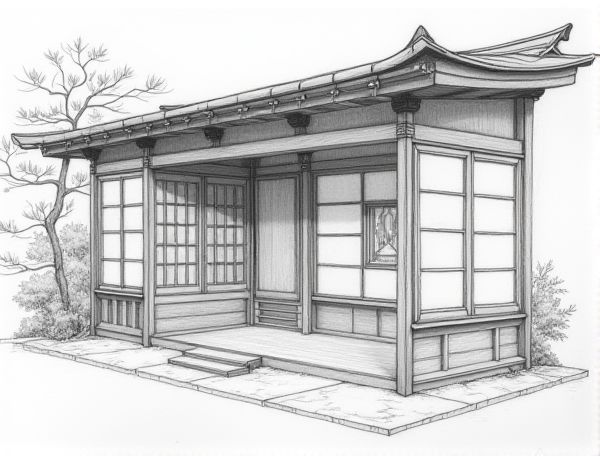
Photo illustration: Japandi home design with shoji screen dividers
Japandi home design seamlessly blends Japanese minimalism with Scandinavian functionality, creating serene, clutter-free spaces enhanced by shoji screen dividers that offer both privacy and natural light diffusion. Discover how incorporating these elegant screens can transform your living area by reading more in the article.
Introduction to Japandi Home Design
Japandi home design merges Japanese minimalism with Scandinavian functionality, creating a serene and clutter-free living space. This style emphasizes natural materials like wood and bamboo, neutral color palettes, and clean lines to foster tranquility and simplicity. Key elements include functional furniture, ample natural light, and the integration of nature indoors, promoting a balanced and harmonious environment.
The Core Principles of Japandi Aesthetics
Japandi aesthetics blend Japanese minimalism with Scandinavian functionality, emphasizing clean lines, neutral colors, and natural materials to create serene, clutter-free living spaces. Your home design can achieve harmony by incorporating handcrafted wooden furniture, soft textiles, and a balance of simplicity and warmth that fosters both comfort and mindfulness.
Benefits of Integrating Shoji Screens
Integrating Shoji screens in your home design enhances natural light diffusion while maintaining privacy, creating a serene and spacious ambiance. Their lightweight, modular structure allows for flexible room division and adds a timeless aesthetic that complements minimalist and traditional interiors.
Harmonizing Japanese and Scandinavian Elements
Harmonizing Japanese and Scandinavian elements creates a balanced home design emphasizing simplicity, natural materials, and functional aesthetics. Your living space can benefit from the warm minimalism of Scandinavian style combined with the tranquil elegance and clean lines of Japanese decor.
Selecting Materials for Shoji Screen Dividers
Selecting materials for Shoji screen dividers involves prioritizing lightweight, durable options like traditional rice paper combined with a sturdy wooden frame such as cedar or bamboo. Opting for translucent rice paper enhances natural light diffusion while maintaining privacy, and choosing sustainably sourced wood supports eco-friendly interior design practices.
Maximizing Natural Light with Shoji Screens
Shoji screens enhance home design by maximizing natural light while maintaining privacy, featuring translucent washi paper that diffuses sunlight evenly across rooms. Their lightweight wooden frames allow for flexible placement, creating bright, airy spaces that reduce the need for artificial lighting. Integrating Shoji screens boosts energy efficiency and promotes a serene, minimalist aesthetic in interior environments.
Functional Zoning in Japandi Interiors
Functional zoning in Japandi interiors maximizes space efficiency by thoughtfully dividing areas to balance minimalism and comfort, incorporating natural materials like wood and bamboo to create seamless transitions between living, dining, and relaxation zones. Your design should emphasize multipurpose furniture and clean lines to enhance flow and maintain the serene, clutter-free aesthetic central to Japandi style.
Minimalist Decor Tips with Shoji Accents
Incorporate Shoji accents into your minimalist home design by utilizing translucent paper screens to create soft, diffused natural light that enhances the space's simplicity and calm. Emphasize clean lines and a neutral color palette to complement the Shoji's traditional Japanese aesthetic while maintaining functional, clutter-free areas.
Shoji Screens for Modern Open-Plan Spaces
Shoji screens enhance modern open-plan spaces by providing flexible room division while maintaining natural light flow through their translucent washi paper panels. Their minimalist wooden frames blend seamlessly with contemporary interiors, adding a touch of Japanese elegance and privacy without sacrificing openness.
Maintenance and Care for Shoji Dividers
Shoji dividers require regular dusting with a soft cloth and occasional cleaning with a damp sponge to maintain their delicate paper panels and wooden frames. Avoid exposure to direct sunlight and high humidity to prevent warping and discoloration, ensuring long-lasting elegance in your home design.
 homedesy.com
homedesy.com